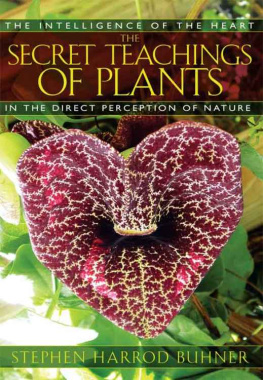
For Trishuwa
who completed the education of my heart
Where does the power come from
to see the race to its end?
From within.
PRAISE FORTHE SECRET TEACHINGS OF PLANTS
I learned more from part one of this magnificent book than from any source in years. Buhner writes of complex discoveries in neuroscience and neurocardiology with clarity and coherence. Encompassing the highest spiritual insights of such giants as Blake, Goethe, and Whitman, part two is worthy poetry in itself, offering readers a unique way to move into transcendent realms. Of the truly great books appearing today, The Secret Teachings of Plants is easily the most rewarding I have had the privilege of reading.
JOSEPH CHILTON PEARCE, AUTHOR OF
THE BIOLOGY OF TRANSCENDENCE
In this wonderful book Stephen Buhner shows us that the heart is not a machine but the informed, intelligent core of our emotional, spiritual, and perceptual universe. Through the heart we can perceive the living spirit that diffuses through the green world that is our natural home. Required reading for all owners of a heart.
MATTHEW WOOD, HERBALIST AND AUTHOR OF
THE BOOK OF HERBAL WISDOM
Beautifully written, The Secret Teachings of Plants is a work of artas much a poetical journey into the essence of plants as it is a guidebook on how to use plant medicine in our healing practices. Stephen Buhner is among the plant geniuses of our time. Like Thoreau and Goethe and Luther Burbank, the master gardeners and green men he so liberally quotes throughout, Buhner will be long remembered for his deep and introspective connection with the green world and for his ability to connect us to the heart of the plants through his teachings.
ROSEMARY GLADSTAR, AUTHOR OFROSEMARY GLADSTARS FAMILY
HERBAL AND FOUNDER OF UNITED PLANT SAVERS
Buhners writings are a powerful call for people to work together to restore the sacredness of Earth.
BROOKE MEDICINE EAGLE, AUTHOR OF
BUFFALO WOMAN COMES SINGING

ACKNOWLEDGMENTS

Trishuwa who endured; Don Babineau who asked that it be written; Kate Gilday who asked that it be taught; Kathleen Maier who hosted the first weekends; Dale Pendell whose work birthed the form; Robert Bly for permission to use his translations of Goethe, Machado, Mirabai, Jiminez, and Baudelaire and especially his metaphor of the long bag we drag behind us; Benoit Mandelbrot for seeing the world with a childs eyes, Henri Bortoft for giraffes and insight; Henri Corbin for expressing the inexpressible; Rosita Arvigo and Matthew Wood for living a life expressed out of the reality of plant intelligence; James Hillman for his teachings of the heart; and Goethe, Henry David Thoreau, Luther Burbank, and Masanobu Fukuoka whose writings and lives stand testament to the intelligence of Nature.

Thanks are gratefully extended to the following publishers and authors for permission to reprint:
from Living with Barbarians: A Few Plant Poems by Dale Pendell, copyright 1999. Published by Wild Ginger Press, Sebastapol, California. Used by permission of the author.
from The Taste of Wild Water: Poems and Stories Found While Walking in Woods by Stephen Harrod Buhner, copyright 2003. Published by Raven Press, Randolph, Vermont. Used by permission of the author.
from The Kabir Book by Robert Bly, copyright 1971, 1977 Robert Bly, copyright 1977 The Seventies Press. Reprinted by Permission of Beacon Press, Boston.
from Synergetics: Explorations in the Geometry of Thinking by R. Buck-minster Fuller, N.Y.: Macmillan, 1975. (c) The Estate of R. Buckminster Fuller, by permission of the estate.
from Goethes Scientific Consciousness by Henri Bortoft, copyright 1986. Published by The Institute for Cultural Research, Kent, England. Used by permission of the author.
from The Thought of the Heart and the Soul of the World by James Hillman, copyright 1995. Published by Spring Publications, Putnam, Connecticut, 2004. Used by permission of Spring Publications.
from Fractal Physiology and Chaos in Medicine by Bruce West, copyright 1990. Published by World Scientific, River Edge, New Jersey. Used by permission of the publisher.
from News of the Universe: Poems of Twofold Consciousness by Robert Bly, copyright 1980. Published by Sierra Club Books, San Francisco, California. Used by permission of the author.

CONTENTS






A NOTE TO THE READER

The first half of this book is linear, the second half is not. The first half is filled with analytical explanations of why and howthe second half is filled with poetry and doing. The first half of the book is called systole the second diastole to reflect the different natures of these two halves. The terms are usually used to describe the functioning of the heart. Systole is when the heart contracts, forcing blood outward away from the heart. Diastole is when the heart relaxes and fills once more. This book reflects that patternthe movement away from the heart and the relaxation and movement inward as the heart fills again. In a sense this is one of the oldest patterns we know. Still, we have spent a long time as a culture in the systolic and you may find you arent in the mood for more of it. So dont read the first half of this book if you dont want toit is there if you want explanations later.
Feel free to skip around and read this book in any order you wish, choosing whichever chapter interests you and leaving those that do not. It doesnt matter, for the things that you need to find you will find, if only you will follow your heart.
I have long seen that each grain of knowledge I acquired, going to school to Nature, was added to each other grain I possessed, that these grains grew into a foundation stone, that the stones accumulated until I had a substructure, and that on that substructure I could build me a house. And I have seen, too, that there are enough buildings in Natures system of knowledge to make a great city of wisdom.
Next page








